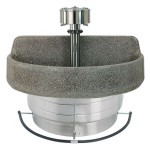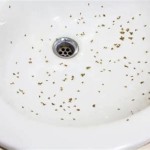Putting Stones in Your Bathroom Sink: Aesthetics and Functionality
The integration of natural elements into interior design continues to gain traction as homeowners seek to create tranquil and visually appealing spaces. Utilizing stones in the bathroom sink is one such trend, offering a unique blend of aesthetics and potential functionality. However, the decision to incorporate stones into a sink requires careful consideration of various factors, including the type of stones chosen, their arrangement, and the potential impact on plumbing and sanitation.
The primary appeal of placing stones in a bathroom sink is undoubtedly aesthetic. They introduce an organic texture and visual interest that contrasts with the smooth, often sterile, surfaces typically found in bathrooms. Stones can evoke feelings of nature, creating a spa-like atmosphere conducive to relaxation. The variety of available stone types, colors, and sizes provides ample opportunity for customization, allowing individuals to tailor the sink's appearance to their personal preferences and the overall design scheme of the bathroom.
While aesthetics are paramount, it is crucial to evaluate the practical implications of placing stones in a sink. The chosen stones should be non-porous to prevent the absorption of water and soap residue, which can lead to staining, bacterial growth, and unpleasant odors. Furthermore, the arrangement of the stones must not impede the flow of water or obstruct the drain. A poorly designed arrangement can lead to water pooling and increased cleaning effort. It is also important to consider the potential impact on the sink's functionality, such as the ability to easily wash hands or clean the sink itself.
Stone Selection and Preparation
The selection of appropriate stones is fundamental to the success of this design element. Several factors should guide the selection process. Impermeability is the most critical characteristic. Dense, non-porous stones like river rocks, polished granite pebbles, or certain types of smooth sea glass are generally suitable. Porous stones, such as limestone or sandstone, should be avoided as they readily absorb moisture and are prone to staining and bacterial growth. Color and size are also important considerations, as they should complement the existing bathroom decor and fit comfortably within the sink basin without overcrowding it.
Before placing the stones in the sink, thorough cleaning and preparation are essential. Each stone should be scrubbed with a mild detergent and rinsed thoroughly to remove any dirt, debris, or loose particles. After cleaning, the stones should be completely dried. Some individuals choose to seal the stones with a non-toxic sealant designed for use in wet environments. This sealant can provide an extra layer of protection against water absorption and staining. However, it is crucial to select a sealant that is specifically formulated for use on natural stone and is safe for plumbing systems.
Considerations regarding the stone's texture are also important. While a slightly rough texture can enhance the natural aesthetic, excessively sharp or jagged stones should be avoided as they can pose a risk of cuts or scratches. Smooth, rounded stones are generally the safest and most comfortable option for use in a sink.
Arrangement and Drainage
The arrangement of the stones within the sink is a critical factor affecting both aesthetics and functionality. The primary goal is to create a visually appealing display without impeding the flow of water or obstructing the drain. One common approach is to create a single layer of stones that covers the bottom of the sink basin. This arrangement provides a uniform appearance and allows water to flow freely between the stones.
It is crucial to ensure that the stones do not completely cover the drain opening. A small gap should be left around the drain to prevent blockage and allow for efficient drainage. Some individuals choose to use a drain cover or strainer to further prevent stones from accidentally falling into the drainpipe. Regular cleaning of the drain cover or strainer is important to prevent buildup of hair and other debris.
Alternatives to a single-layer arrangement include creating small mounds or clusters of stones. This can add visual interest and dimension to the sink. However, it is essential to ensure that these mounds do not obstruct the flow of water or create areas where water can pool. Regular observation of the water flow is recommended to identify any potential problem areas and adjust the arrangement accordingly. The stones should be arranged to allow for easy cleaning of the sink basin itself. A grouping that can be easily moved or removed facilitates a more thorough cleaning process.
Maintenance and Hygiene
Maintaining the cleanliness and hygiene of stones in a bathroom sink requires regular effort. The stones should be rinsed regularly with water to remove any soap residue or debris. Periodically, the stones should be removed from the sink and scrubbed with a mild detergent and a soft brush. This helps to prevent the buildup of stains, mold, and bacteria.
The type of cleaning products used is also important. Harsh chemicals and abrasive cleaners should be avoided as they can damage the stones' surface and potentially leach harmful substances into the water supply. Instead, opt for gentle, non-toxic cleaning solutions specifically designed for use on natural stone. Vinegar and water solutions can also be effective for removing mineral deposits and soap scum.
In addition to cleaning the stones themselves, it is crucial to maintain the cleanliness of the sink basin. The sink should be cleaned regularly with a non-abrasive cleaner to prevent the buildup of grime and bacteria. Pay particular attention to the area around the drain, as this is where debris tends to accumulate. Addressing any signs of mold or mildew promptly is essential. A solution of bleach and water can be used to kill mold, but it is important to rinse the sink thoroughly afterward to remove any residual bleach.
Furthermore, the stones should be inspected regularly for any signs of damage, such as cracks or chips. Damaged stones can harbor bacteria and may need to be replaced. Replacing damaged stones promptly helps to maintain the aesthetic appeal and hygiene of the sink.
The use of stones in a bathroom sink presents a unique design element that can introduce natural beauty into the space. However, a successful implementation relies on a careful assessment of stone properties, thoughtful design, and persistent maintenance. When these considerations are met, the integration of stones into the bathroom sink provides both visual appeal and a touch of serenity.

Rocks In The Sink I Love It Rock Decor Powder Room Redo Bathroom Furnishings

How To Make A Stunning River Rock Bathroom Vanity Top Hometalk

Rocks In The Sink Bathroom Diy Modern

Rocks In A Bathroom Sink Love Decor Apartment

River Rocks In Our Bathroom Sink Interior Design Inspiration

Carving A Stone Sink May Be Easier Than You Think Make

Rocks In The Bathroom 12 Beautiful Design Ideas

Bathroom Sink Love The Glass With Stone Under It Creative Small Makeover

How To Carve A Better Stone Sink In 4 Hrs

Create A Birdbath From Salvaged Sink
Related Posts







